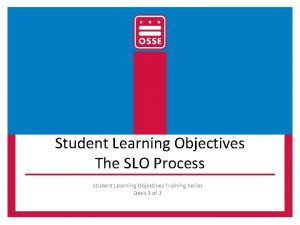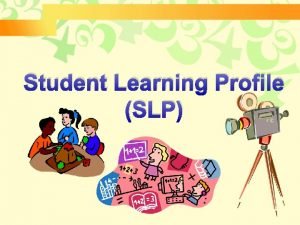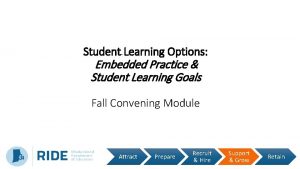STUDENT LEARNING TIME STUDENT LEARNING TIME The Student











- Slides: 11

STUDENT LEARNING TIME

STUDENT LEARNING TIME The Student Learning Time (or more commonly known amongst academicians as SLT) is a guided time management system to simulate the amount of time expected for a particular student to spend on learning.

STUDENT LEARNING TIME

STUDENT LEARNING TIME The Learning Outcomes Student achievements are measured by learning outcomes. These learning outcomes distinguish the varying competencies as to what a student will be able to do at the end of a period of study.

STUDENT LEARNING TIME Learning outcomes are based on eight domains: Knowledge; • • Practical skill; Social skills and responsibilities; Values, attitudes and professionalism; Communication, leadership and team skills; Problem solving and scientific skill; Information management and lifelong learning skill; and Managerial and entrepreneurial skills

STUDENT LEARNING TIME Learning outcomes are linked to the credit system which gives value to the entire student learning time and are not based on the contact hours between lecturers and students. MQA has also developed the Codes of Practice for Programme Accreditation (COPPA) and the Codes of Practice for Institutional Audit (COPIA). These Codes of Practice are benchmarked against international good practices and nationally accepted by stakeholders through various consultations.

A credit the agreed-upon value used to measure a student workload in terms of learning time required to complete course units, resulting in learning outcomes’ (UNESCO, 2004) Achievement of Learning Outcomes Teaching/Learning + Assessment e. g. 4 800 national SLT = 120 credits Total SLT 40 Credit THE MEASUREMENT OF STUDENTS’ ACADEMIC LOAD Credit = Teaching Learning Activities Lecture Project Work Study Tour Demonstration Tutorial Presentation Case study Assignments Laboratory Revision Work attachment Group Assignment Examination E-Learning Studio work Clinical Group Discussion Field Work Research Project Industrial training Directed reading STUDENT LEARNING TIME (SLT) 7

FACTORS IN CALCULATING CREDIT Face to Face / Guided Learning Time + Student Self Learning Time + Total Assessment Time

STUDENT LEARNING TIME (SLT)

ASSESSMENT Assessing Students' Learning Outcomes Faulty assumptions about and practices of assessment do more damage by misaligning teaching than any other single factor. As Ramsden (1992) puts it, the assessment is the curriculum, as far as the students are concerned. They will learn what they think they will be assessed on, not what is in the curriculum, or even on what has been 'covered' in class. The trick is, then, to make sure the assessment tasks mirror the ILOs.

Apakah yang dimaksudkan dengan sistem kredit berasaskan Student Learning Time (SLT)? • Student Learning Time (SLT) bermaksud beban sebenar jam pembelajaran pelajar yang mengambil kira semua aktiviti pembelajaran termasuk persediaan material di perpustakaan dan pencarian sumber maklumat di internet. • SLT diambil kira bukannya berasaskan kepada jam kontak antara pensyarah dan pelajar semata.





















